University Population Health: Social Determinants Impact Report
VerifiedAdded on 2023/06/10
|12
|3680
|377
Report
AI Summary
This report analyzes the impact of social determinants on population health, specifically focusing on the First Nation population in Canada and the influence of early life experiences. It identifies and categorizes social determinants into upstream, midstream, and downstream factors, examining their interactions and effects on health outcomes. The report highlights the role of global and intermediate determinants, such as economic policies and psychosocial factors like stress and trauma, and their effects on health behaviors and access to resources. It also addresses the downstream or micro factors like physiological systems, hormonal imbalance and immunity. The report discusses how early life conditions impact long-term physical and mental health, the role of political and psychological issues, and the government's efforts to address these issues through policies and support programs. The report also addresses cultural factors, diet, and the challenges faced by the First Nation population in accessing education and equal opportunities, and the historical context of racism and oppression.
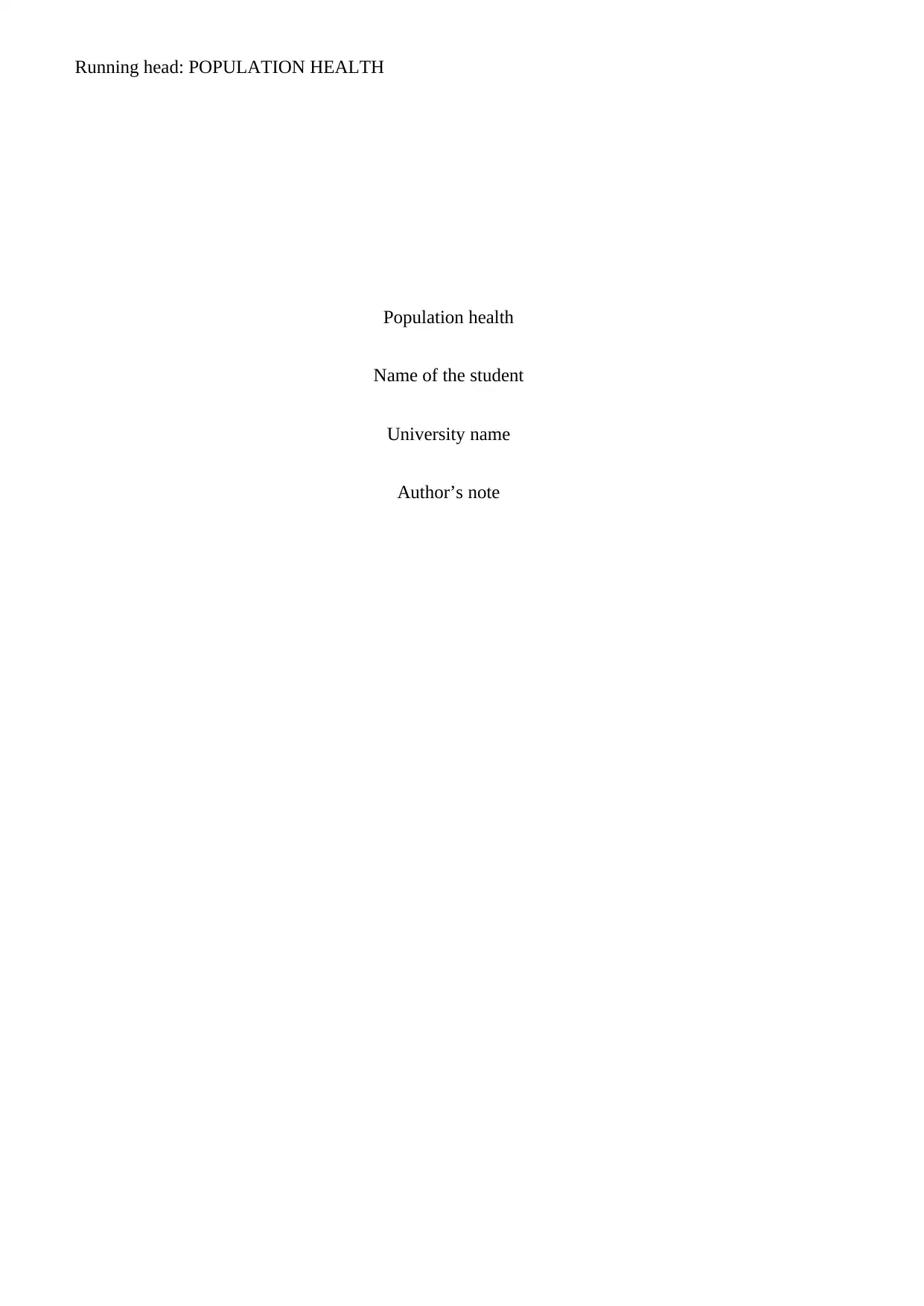
Running head: POPULATION HEALTH
Population health
Name of the student
University name
Author’s note
Population health
Name of the student
University name
Author’s note
Paraphrase This Document
Need a fresh take? Get an instant paraphrase of this document with our AI Paraphraser
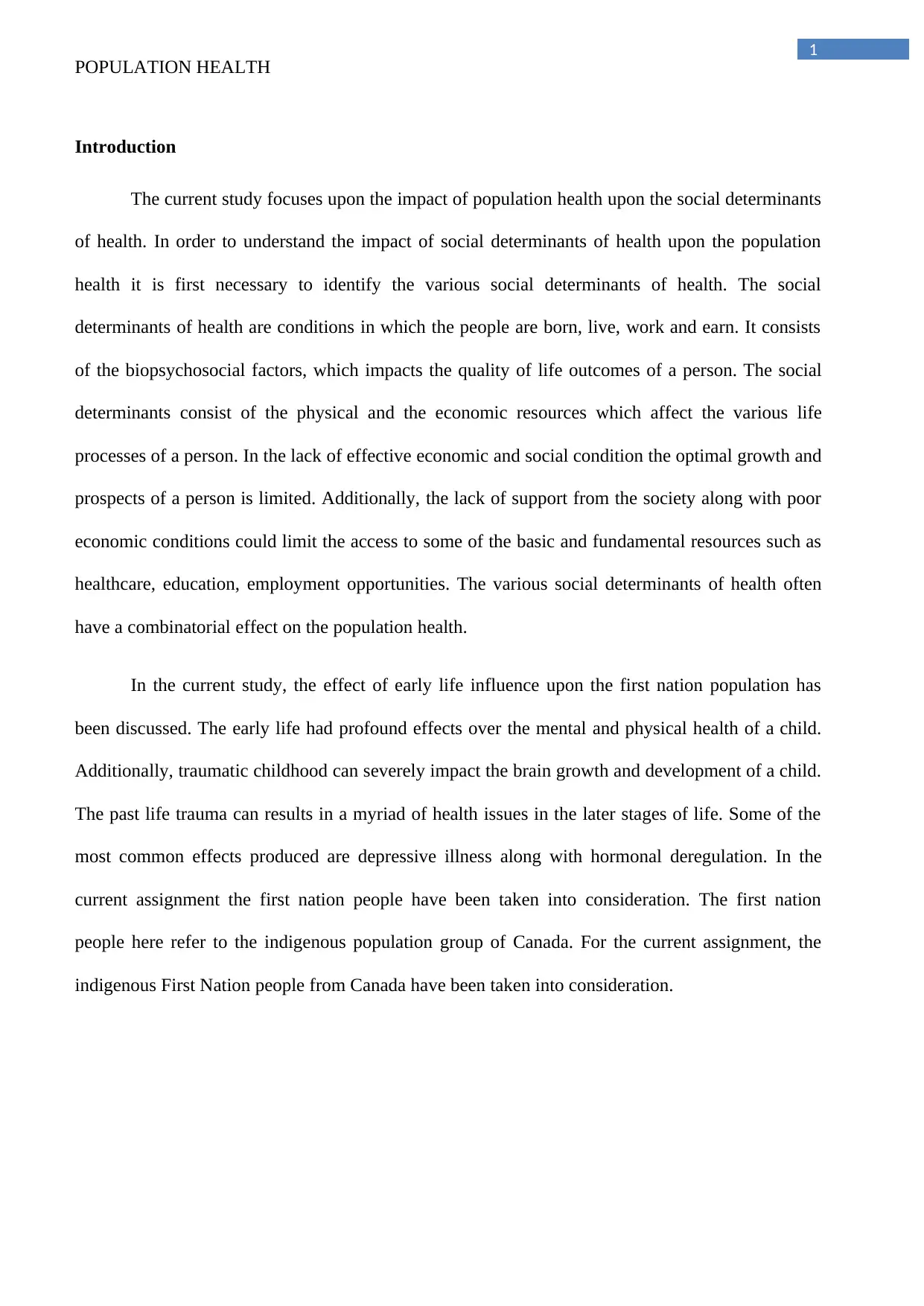
1
POPULATION HEALTH
Introduction
The current study focuses upon the impact of population health upon the social determinants
of health. In order to understand the impact of social determinants of health upon the population
health it is first necessary to identify the various social determinants of health. The social
determinants of health are conditions in which the people are born, live, work and earn. It consists
of the biopsychosocial factors, which impacts the quality of life outcomes of a person. The social
determinants consist of the physical and the economic resources which affect the various life
processes of a person. In the lack of effective economic and social condition the optimal growth and
prospects of a person is limited. Additionally, the lack of support from the society along with poor
economic conditions could limit the access to some of the basic and fundamental resources such as
healthcare, education, employment opportunities. The various social determinants of health often
have a combinatorial effect on the population health.
In the current study, the effect of early life influence upon the first nation population has
been discussed. The early life had profound effects over the mental and physical health of a child.
Additionally, traumatic childhood can severely impact the brain growth and development of a child.
The past life trauma can results in a myriad of health issues in the later stages of life. Some of the
most common effects produced are depressive illness along with hormonal deregulation. In the
current assignment the first nation people have been taken into consideration. The first nation
people here refer to the indigenous population group of Canada. For the current assignment, the
indigenous First Nation people from Canada have been taken into consideration.
POPULATION HEALTH
Introduction
The current study focuses upon the impact of population health upon the social determinants
of health. In order to understand the impact of social determinants of health upon the population
health it is first necessary to identify the various social determinants of health. The social
determinants of health are conditions in which the people are born, live, work and earn. It consists
of the biopsychosocial factors, which impacts the quality of life outcomes of a person. The social
determinants consist of the physical and the economic resources which affect the various life
processes of a person. In the lack of effective economic and social condition the optimal growth and
prospects of a person is limited. Additionally, the lack of support from the society along with poor
economic conditions could limit the access to some of the basic and fundamental resources such as
healthcare, education, employment opportunities. The various social determinants of health often
have a combinatorial effect on the population health.
In the current study, the effect of early life influence upon the first nation population has
been discussed. The early life had profound effects over the mental and physical health of a child.
Additionally, traumatic childhood can severely impact the brain growth and development of a child.
The past life trauma can results in a myriad of health issues in the later stages of life. Some of the
most common effects produced are depressive illness along with hormonal deregulation. In the
current assignment the first nation people have been taken into consideration. The first nation
people here refer to the indigenous population group of Canada. For the current assignment, the
indigenous First Nation people from Canada have been taken into consideration.
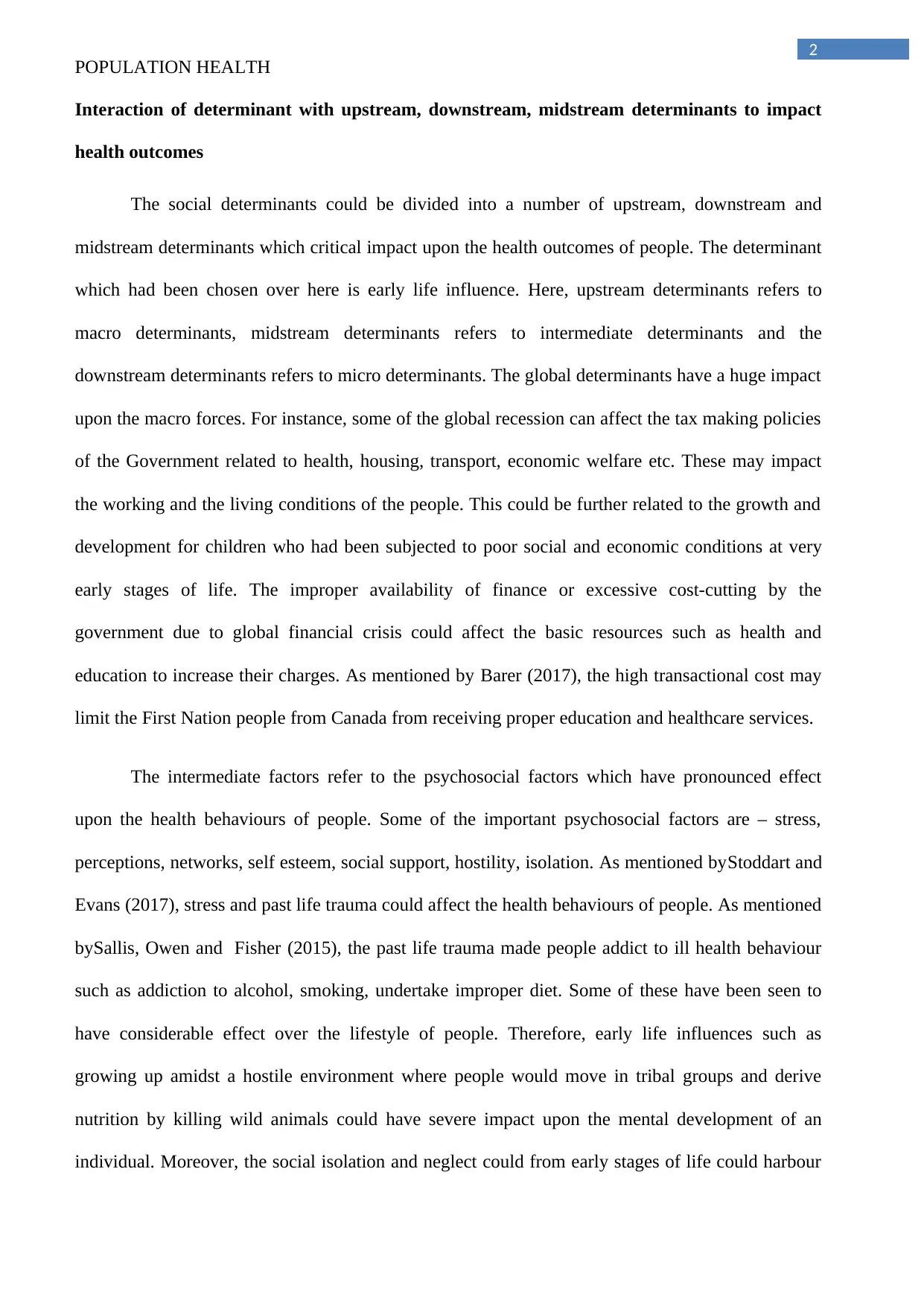
2
POPULATION HEALTH
Interaction of determinant with upstream, downstream, midstream determinants to impact
health outcomes
The social determinants could be divided into a number of upstream, downstream and
midstream determinants which critical impact upon the health outcomes of people. The determinant
which had been chosen over here is early life influence. Here, upstream determinants refers to
macro determinants, midstream determinants refers to intermediate determinants and the
downstream determinants refers to micro determinants. The global determinants have a huge impact
upon the macro forces. For instance, some of the global recession can affect the tax making policies
of the Government related to health, housing, transport, economic welfare etc. These may impact
the working and the living conditions of the people. This could be further related to the growth and
development for children who had been subjected to poor social and economic conditions at very
early stages of life. The improper availability of finance or excessive cost-cutting by the
government due to global financial crisis could affect the basic resources such as health and
education to increase their charges. As mentioned by Barer (2017), the high transactional cost may
limit the First Nation people from Canada from receiving proper education and healthcare services.
The intermediate factors refer to the psychosocial factors which have pronounced effect
upon the health behaviours of people. Some of the important psychosocial factors are – stress,
perceptions, networks, self esteem, social support, hostility, isolation. As mentioned byStoddart and
Evans (2017), stress and past life trauma could affect the health behaviours of people. As mentioned
bySallis, Owen and Fisher (2015), the past life trauma made people addict to ill health behaviour
such as addiction to alcohol, smoking, undertake improper diet. Some of these have been seen to
have considerable effect over the lifestyle of people. Therefore, early life influences such as
growing up amidst a hostile environment where people would move in tribal groups and derive
nutrition by killing wild animals could have severe impact upon the mental development of an
individual. Moreover, the social isolation and neglect could from early stages of life could harbour
POPULATION HEALTH
Interaction of determinant with upstream, downstream, midstream determinants to impact
health outcomes
The social determinants could be divided into a number of upstream, downstream and
midstream determinants which critical impact upon the health outcomes of people. The determinant
which had been chosen over here is early life influence. Here, upstream determinants refers to
macro determinants, midstream determinants refers to intermediate determinants and the
downstream determinants refers to micro determinants. The global determinants have a huge impact
upon the macro forces. For instance, some of the global recession can affect the tax making policies
of the Government related to health, housing, transport, economic welfare etc. These may impact
the working and the living conditions of the people. This could be further related to the growth and
development for children who had been subjected to poor social and economic conditions at very
early stages of life. The improper availability of finance or excessive cost-cutting by the
government due to global financial crisis could affect the basic resources such as health and
education to increase their charges. As mentioned by Barer (2017), the high transactional cost may
limit the First Nation people from Canada from receiving proper education and healthcare services.
The intermediate factors refer to the psychosocial factors which have pronounced effect
upon the health behaviours of people. Some of the important psychosocial factors are – stress,
perceptions, networks, self esteem, social support, hostility, isolation. As mentioned byStoddart and
Evans (2017), stress and past life trauma could affect the health behaviours of people. As mentioned
bySallis, Owen and Fisher (2015), the past life trauma made people addict to ill health behaviour
such as addiction to alcohol, smoking, undertake improper diet. Some of these have been seen to
have considerable effect over the lifestyle of people. Therefore, early life influences such as
growing up amidst a hostile environment where people would move in tribal groups and derive
nutrition by killing wild animals could have severe impact upon the mental development of an
individual. Moreover, the social isolation and neglect could from early stages of life could harbour
⊘ This is a preview!⊘
Do you want full access?
Subscribe today to unlock all pages.

Trusted by 1+ million students worldwide
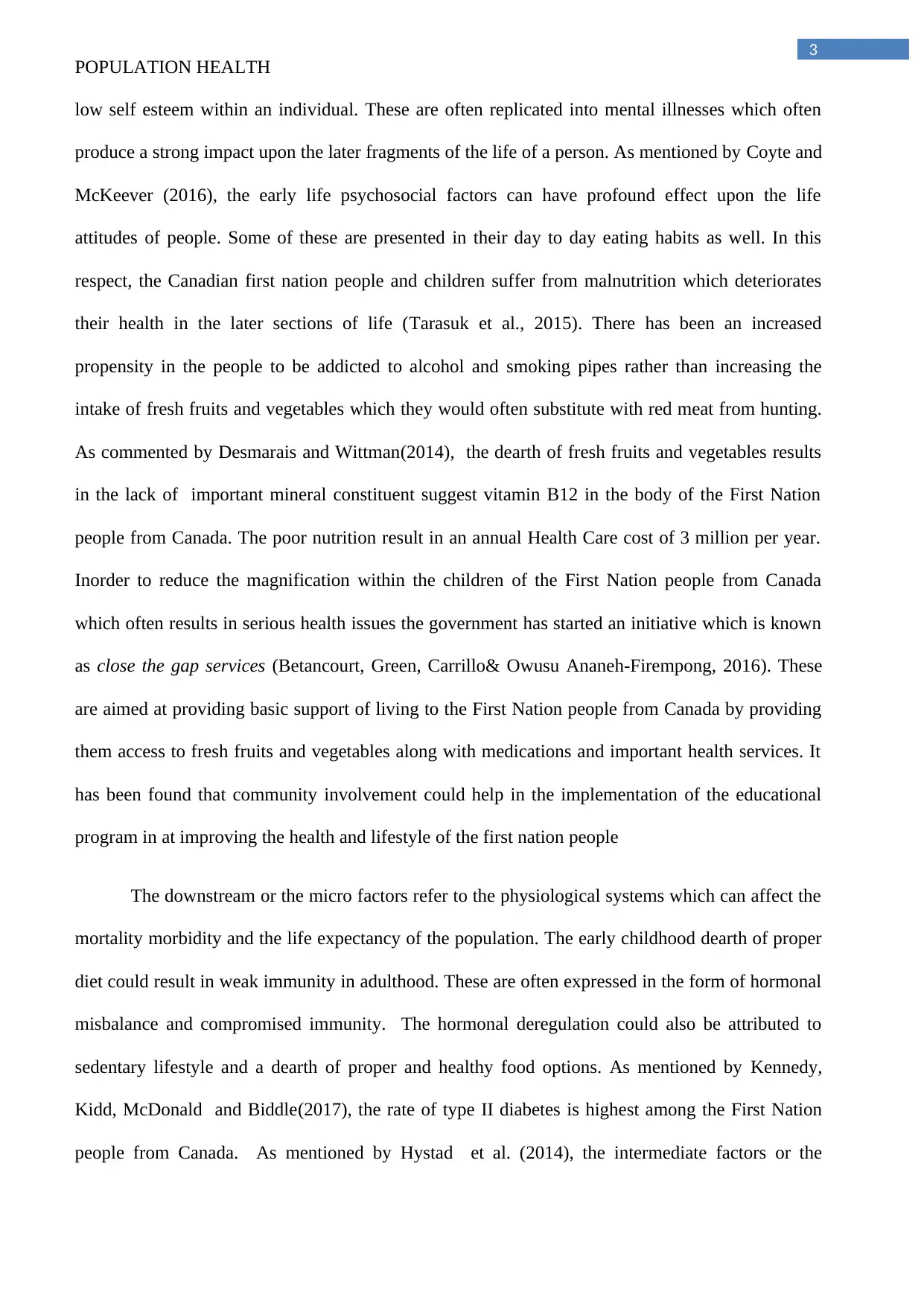
3
POPULATION HEALTH
low self esteem within an individual. These are often replicated into mental illnesses which often
produce a strong impact upon the later fragments of the life of a person. As mentioned by Coyte and
McKeever (2016), the early life psychosocial factors can have profound effect upon the life
attitudes of people. Some of these are presented in their day to day eating habits as well. In this
respect, the Canadian first nation people and children suffer from malnutrition which deteriorates
their health in the later sections of life (Tarasuk et al., 2015). There has been an increased
propensity in the people to be addicted to alcohol and smoking pipes rather than increasing the
intake of fresh fruits and vegetables which they would often substitute with red meat from hunting.
As commented by Desmarais and Wittman(2014), the dearth of fresh fruits and vegetables results
in the lack of important mineral constituent suggest vitamin B12 in the body of the First Nation
people from Canada. The poor nutrition result in an annual Health Care cost of 3 million per year.
Inorder to reduce the magnification within the children of the First Nation people from Canada
which often results in serious health issues the government has started an initiative which is known
as close the gap services (Betancourt, Green, Carrillo& Owusu Ananeh-Firempong, 2016). These
are aimed at providing basic support of living to the First Nation people from Canada by providing
them access to fresh fruits and vegetables along with medications and important health services. It
has been found that community involvement could help in the implementation of the educational
program in at improving the health and lifestyle of the first nation people
The downstream or the micro factors refer to the physiological systems which can affect the
mortality morbidity and the life expectancy of the population. The early childhood dearth of proper
diet could result in weak immunity in adulthood. These are often expressed in the form of hormonal
misbalance and compromised immunity. The hormonal deregulation could also be attributed to
sedentary lifestyle and a dearth of proper and healthy food options. As mentioned by Kennedy,
Kidd, McDonald and Biddle(2017), the rate of type II diabetes is highest among the First Nation
people from Canada. As mentioned by Hystad et al. (2014), the intermediate factors or the
POPULATION HEALTH
low self esteem within an individual. These are often replicated into mental illnesses which often
produce a strong impact upon the later fragments of the life of a person. As mentioned by Coyte and
McKeever (2016), the early life psychosocial factors can have profound effect upon the life
attitudes of people. Some of these are presented in their day to day eating habits as well. In this
respect, the Canadian first nation people and children suffer from malnutrition which deteriorates
their health in the later sections of life (Tarasuk et al., 2015). There has been an increased
propensity in the people to be addicted to alcohol and smoking pipes rather than increasing the
intake of fresh fruits and vegetables which they would often substitute with red meat from hunting.
As commented by Desmarais and Wittman(2014), the dearth of fresh fruits and vegetables results
in the lack of important mineral constituent suggest vitamin B12 in the body of the First Nation
people from Canada. The poor nutrition result in an annual Health Care cost of 3 million per year.
Inorder to reduce the magnification within the children of the First Nation people from Canada
which often results in serious health issues the government has started an initiative which is known
as close the gap services (Betancourt, Green, Carrillo& Owusu Ananeh-Firempong, 2016). These
are aimed at providing basic support of living to the First Nation people from Canada by providing
them access to fresh fruits and vegetables along with medications and important health services. It
has been found that community involvement could help in the implementation of the educational
program in at improving the health and lifestyle of the first nation people
The downstream or the micro factors refer to the physiological systems which can affect the
mortality morbidity and the life expectancy of the population. The early childhood dearth of proper
diet could result in weak immunity in adulthood. These are often expressed in the form of hormonal
misbalance and compromised immunity. The hormonal deregulation could also be attributed to
sedentary lifestyle and a dearth of proper and healthy food options. As mentioned by Kennedy,
Kidd, McDonald and Biddle(2017), the rate of type II diabetes is highest among the First Nation
people from Canada. As mentioned by Hystad et al. (2014), the intermediate factors or the
Paraphrase This Document
Need a fresh take? Get an instant paraphrase of this document with our AI Paraphraser
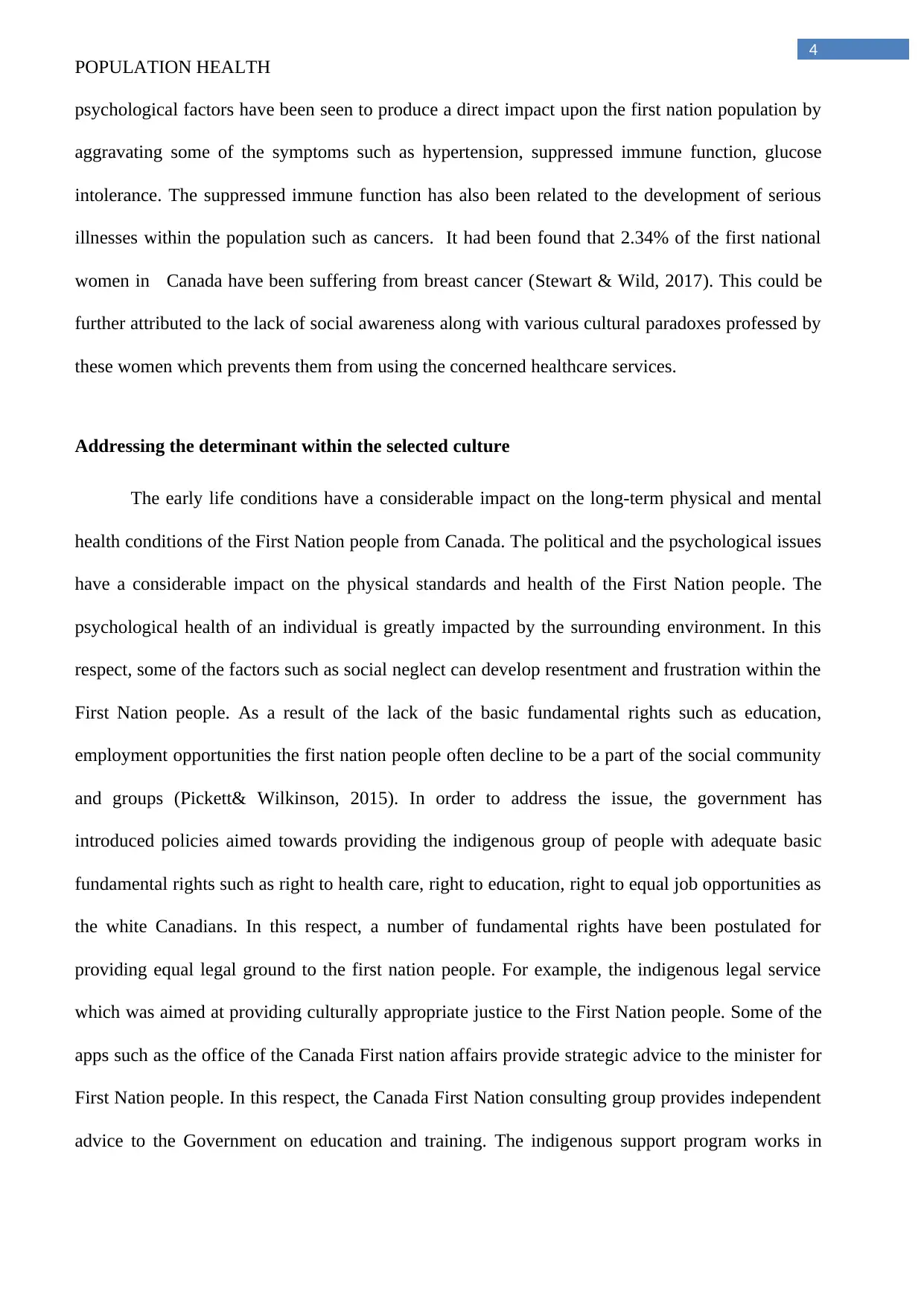
4
POPULATION HEALTH
psychological factors have been seen to produce a direct impact upon the first nation population by
aggravating some of the symptoms such as hypertension, suppressed immune function, glucose
intolerance. The suppressed immune function has also been related to the development of serious
illnesses within the population such as cancers. It had been found that 2.34% of the first national
women in Canada have been suffering from breast cancer (Stewart & Wild, 2017). This could be
further attributed to the lack of social awareness along with various cultural paradoxes professed by
these women which prevents them from using the concerned healthcare services.
Addressing the determinant within the selected culture
The early life conditions have a considerable impact on the long-term physical and mental
health conditions of the First Nation people from Canada. The political and the psychological issues
have a considerable impact on the physical standards and health of the First Nation people. The
psychological health of an individual is greatly impacted by the surrounding environment. In this
respect, some of the factors such as social neglect can develop resentment and frustration within the
First Nation people. As a result of the lack of the basic fundamental rights such as education,
employment opportunities the first nation people often decline to be a part of the social community
and groups (Pickett& Wilkinson, 2015). In order to address the issue, the government has
introduced policies aimed towards providing the indigenous group of people with adequate basic
fundamental rights such as right to health care, right to education, right to equal job opportunities as
the white Canadians. In this respect, a number of fundamental rights have been postulated for
providing equal legal ground to the first nation people. For example, the indigenous legal service
which was aimed at providing culturally appropriate justice to the First Nation people. Some of the
apps such as the office of the Canada First nation affairs provide strategic advice to the minister for
First Nation people. In this respect, the Canada First Nation consulting group provides independent
advice to the Government on education and training. The indigenous support program works in
POPULATION HEALTH
psychological factors have been seen to produce a direct impact upon the first nation population by
aggravating some of the symptoms such as hypertension, suppressed immune function, glucose
intolerance. The suppressed immune function has also been related to the development of serious
illnesses within the population such as cancers. It had been found that 2.34% of the first national
women in Canada have been suffering from breast cancer (Stewart & Wild, 2017). This could be
further attributed to the lack of social awareness along with various cultural paradoxes professed by
these women which prevents them from using the concerned healthcare services.
Addressing the determinant within the selected culture
The early life conditions have a considerable impact on the long-term physical and mental
health conditions of the First Nation people from Canada. The political and the psychological issues
have a considerable impact on the physical standards and health of the First Nation people. The
psychological health of an individual is greatly impacted by the surrounding environment. In this
respect, some of the factors such as social neglect can develop resentment and frustration within the
First Nation people. As a result of the lack of the basic fundamental rights such as education,
employment opportunities the first nation people often decline to be a part of the social community
and groups (Pickett& Wilkinson, 2015). In order to address the issue, the government has
introduced policies aimed towards providing the indigenous group of people with adequate basic
fundamental rights such as right to health care, right to education, right to equal job opportunities as
the white Canadians. In this respect, a number of fundamental rights have been postulated for
providing equal legal ground to the first nation people. For example, the indigenous legal service
which was aimed at providing culturally appropriate justice to the First Nation people. Some of the
apps such as the office of the Canada First nation affairs provide strategic advice to the minister for
First Nation people. In this respect, the Canada First Nation consulting group provides independent
advice to the Government on education and training. The indigenous support program works in
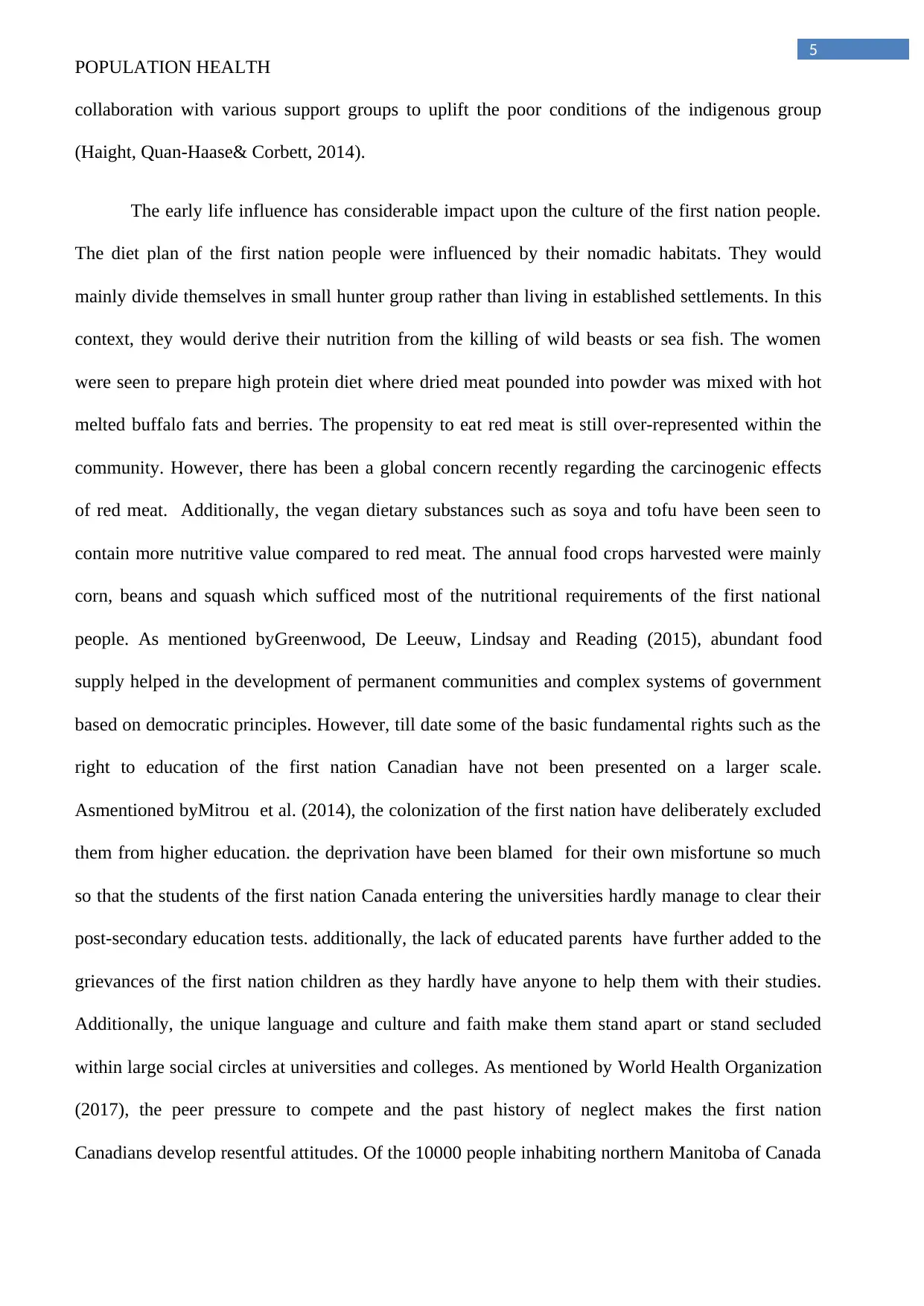
5
POPULATION HEALTH
collaboration with various support groups to uplift the poor conditions of the indigenous group
(Haight, Quan-Haase& Corbett, 2014).
The early life influence has considerable impact upon the culture of the first nation people.
The diet plan of the first nation people were influenced by their nomadic habitats. They would
mainly divide themselves in small hunter group rather than living in established settlements. In this
context, they would derive their nutrition from the killing of wild beasts or sea fish. The women
were seen to prepare high protein diet where dried meat pounded into powder was mixed with hot
melted buffalo fats and berries. The propensity to eat red meat is still over-represented within the
community. However, there has been a global concern recently regarding the carcinogenic effects
of red meat. Additionally, the vegan dietary substances such as soya and tofu have been seen to
contain more nutritive value compared to red meat. The annual food crops harvested were mainly
corn, beans and squash which sufficed most of the nutritional requirements of the first national
people. As mentioned byGreenwood, De Leeuw, Lindsay and Reading (2015), abundant food
supply helped in the development of permanent communities and complex systems of government
based on democratic principles. However, till date some of the basic fundamental rights such as the
right to education of the first nation Canadian have not been presented on a larger scale.
Asmentioned byMitrou et al. (2014), the colonization of the first nation have deliberately excluded
them from higher education. the deprivation have been blamed for their own misfortune so much
so that the students of the first nation Canada entering the universities hardly manage to clear their
post-secondary education tests. additionally, the lack of educated parents have further added to the
grievances of the first nation children as they hardly have anyone to help them with their studies.
Additionally, the unique language and culture and faith make them stand apart or stand secluded
within large social circles at universities and colleges. As mentioned by World Health Organization
(2017), the peer pressure to compete and the past history of neglect makes the first nation
Canadians develop resentful attitudes. Of the 10000 people inhabiting northern Manitoba of Canada
POPULATION HEALTH
collaboration with various support groups to uplift the poor conditions of the indigenous group
(Haight, Quan-Haase& Corbett, 2014).
The early life influence has considerable impact upon the culture of the first nation people.
The diet plan of the first nation people were influenced by their nomadic habitats. They would
mainly divide themselves in small hunter group rather than living in established settlements. In this
context, they would derive their nutrition from the killing of wild beasts or sea fish. The women
were seen to prepare high protein diet where dried meat pounded into powder was mixed with hot
melted buffalo fats and berries. The propensity to eat red meat is still over-represented within the
community. However, there has been a global concern recently regarding the carcinogenic effects
of red meat. Additionally, the vegan dietary substances such as soya and tofu have been seen to
contain more nutritive value compared to red meat. The annual food crops harvested were mainly
corn, beans and squash which sufficed most of the nutritional requirements of the first national
people. As mentioned byGreenwood, De Leeuw, Lindsay and Reading (2015), abundant food
supply helped in the development of permanent communities and complex systems of government
based on democratic principles. However, till date some of the basic fundamental rights such as the
right to education of the first nation Canadian have not been presented on a larger scale.
Asmentioned byMitrou et al. (2014), the colonization of the first nation have deliberately excluded
them from higher education. the deprivation have been blamed for their own misfortune so much
so that the students of the first nation Canada entering the universities hardly manage to clear their
post-secondary education tests. additionally, the lack of educated parents have further added to the
grievances of the first nation children as they hardly have anyone to help them with their studies.
Additionally, the unique language and culture and faith make them stand apart or stand secluded
within large social circles at universities and colleges. As mentioned by World Health Organization
(2017), the peer pressure to compete and the past history of neglect makes the first nation
Canadians develop resentful attitudes. Of the 10000 people inhabiting northern Manitoba of Canada
⊘ This is a preview!⊘
Do you want full access?
Subscribe today to unlock all pages.

Trusted by 1+ million students worldwide
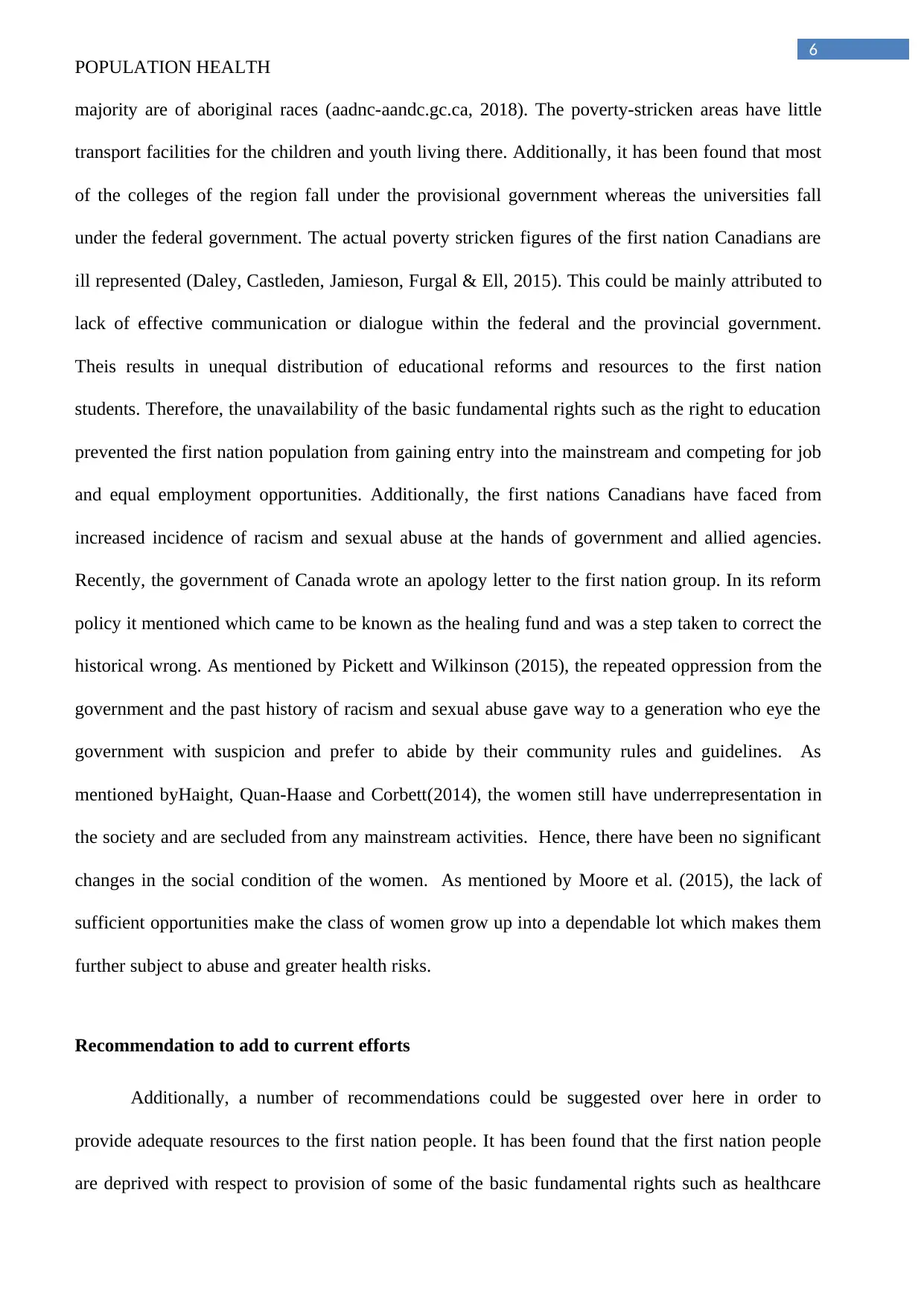
6
POPULATION HEALTH
majority are of aboriginal races (aadnc-aandc.gc.ca, 2018). The poverty-stricken areas have little
transport facilities for the children and youth living there. Additionally, it has been found that most
of the colleges of the region fall under the provisional government whereas the universities fall
under the federal government. The actual poverty stricken figures of the first nation Canadians are
ill represented (Daley, Castleden, Jamieson, Furgal & Ell, 2015). This could be mainly attributed to
lack of effective communication or dialogue within the federal and the provincial government.
Theis results in unequal distribution of educational reforms and resources to the first nation
students. Therefore, the unavailability of the basic fundamental rights such as the right to education
prevented the first nation population from gaining entry into the mainstream and competing for job
and equal employment opportunities. Additionally, the first nations Canadians have faced from
increased incidence of racism and sexual abuse at the hands of government and allied agencies.
Recently, the government of Canada wrote an apology letter to the first nation group. In its reform
policy it mentioned which came to be known as the healing fund and was a step taken to correct the
historical wrong. As mentioned by Pickett and Wilkinson (2015), the repeated oppression from the
government and the past history of racism and sexual abuse gave way to a generation who eye the
government with suspicion and prefer to abide by their community rules and guidelines. As
mentioned byHaight, Quan-Haase and Corbett(2014), the women still have underrepresentation in
the society and are secluded from any mainstream activities. Hence, there have been no significant
changes in the social condition of the women. As mentioned by Moore et al. (2015), the lack of
sufficient opportunities make the class of women grow up into a dependable lot which makes them
further subject to abuse and greater health risks.
Recommendation to add to current efforts
Additionally, a number of recommendations could be suggested over here in order to
provide adequate resources to the first nation people. It has been found that the first nation people
are deprived with respect to provision of some of the basic fundamental rights such as healthcare
POPULATION HEALTH
majority are of aboriginal races (aadnc-aandc.gc.ca, 2018). The poverty-stricken areas have little
transport facilities for the children and youth living there. Additionally, it has been found that most
of the colleges of the region fall under the provisional government whereas the universities fall
under the federal government. The actual poverty stricken figures of the first nation Canadians are
ill represented (Daley, Castleden, Jamieson, Furgal & Ell, 2015). This could be mainly attributed to
lack of effective communication or dialogue within the federal and the provincial government.
Theis results in unequal distribution of educational reforms and resources to the first nation
students. Therefore, the unavailability of the basic fundamental rights such as the right to education
prevented the first nation population from gaining entry into the mainstream and competing for job
and equal employment opportunities. Additionally, the first nations Canadians have faced from
increased incidence of racism and sexual abuse at the hands of government and allied agencies.
Recently, the government of Canada wrote an apology letter to the first nation group. In its reform
policy it mentioned which came to be known as the healing fund and was a step taken to correct the
historical wrong. As mentioned by Pickett and Wilkinson (2015), the repeated oppression from the
government and the past history of racism and sexual abuse gave way to a generation who eye the
government with suspicion and prefer to abide by their community rules and guidelines. As
mentioned byHaight, Quan-Haase and Corbett(2014), the women still have underrepresentation in
the society and are secluded from any mainstream activities. Hence, there have been no significant
changes in the social condition of the women. As mentioned by Moore et al. (2015), the lack of
sufficient opportunities make the class of women grow up into a dependable lot which makes them
further subject to abuse and greater health risks.
Recommendation to add to current efforts
Additionally, a number of recommendations could be suggested over here in order to
provide adequate resources to the first nation people. It has been found that the first nation people
are deprived with respect to provision of some of the basic fundamental rights such as healthcare
Paraphrase This Document
Need a fresh take? Get an instant paraphrase of this document with our AI Paraphraser
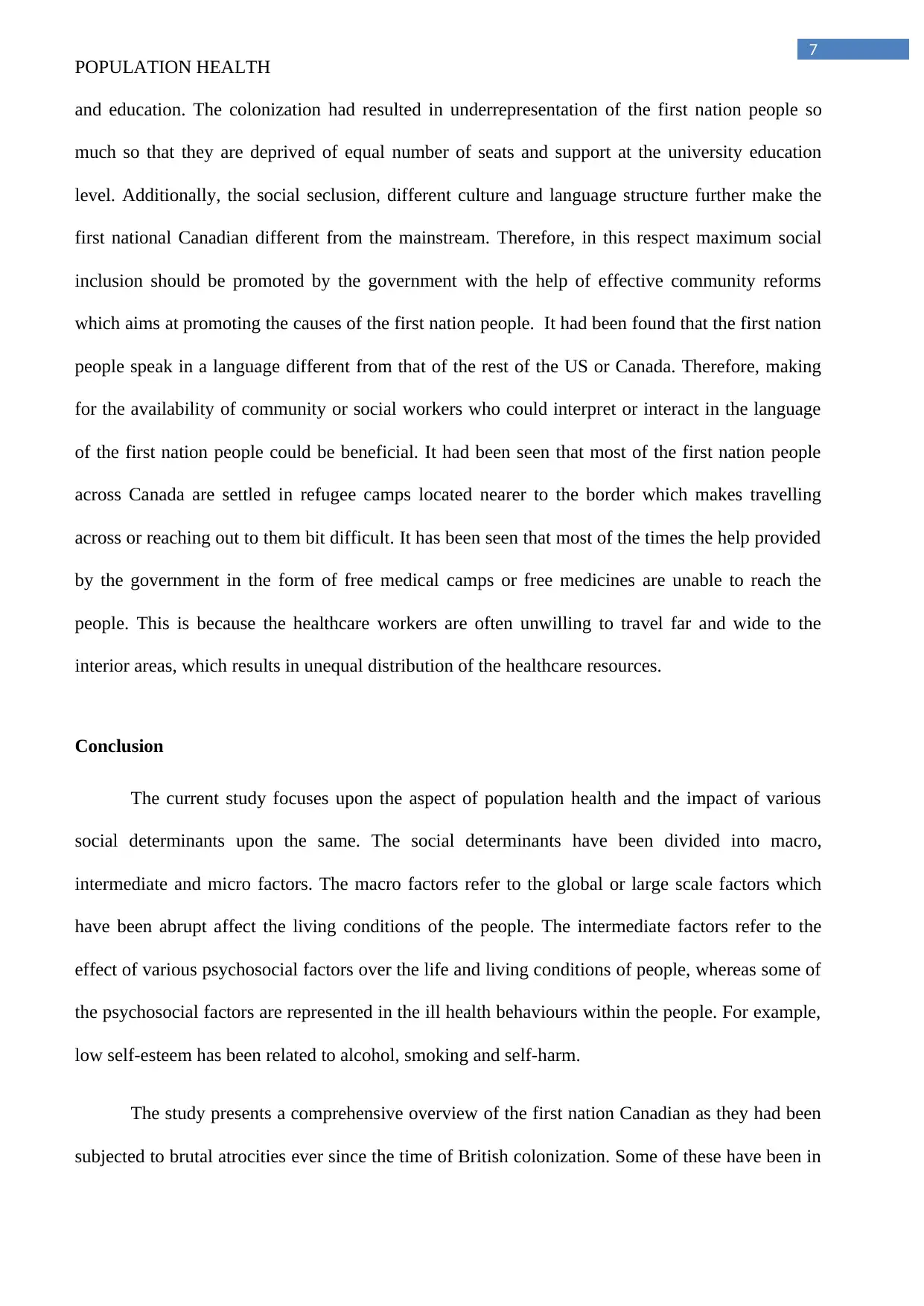
7
POPULATION HEALTH
and education. The colonization had resulted in underrepresentation of the first nation people so
much so that they are deprived of equal number of seats and support at the university education
level. Additionally, the social seclusion, different culture and language structure further make the
first national Canadian different from the mainstream. Therefore, in this respect maximum social
inclusion should be promoted by the government with the help of effective community reforms
which aims at promoting the causes of the first nation people. It had been found that the first nation
people speak in a language different from that of the rest of the US or Canada. Therefore, making
for the availability of community or social workers who could interpret or interact in the language
of the first nation people could be beneficial. It had been seen that most of the first nation people
across Canada are settled in refugee camps located nearer to the border which makes travelling
across or reaching out to them bit difficult. It has been seen that most of the times the help provided
by the government in the form of free medical camps or free medicines are unable to reach the
people. This is because the healthcare workers are often unwilling to travel far and wide to the
interior areas, which results in unequal distribution of the healthcare resources.
Conclusion
The current study focuses upon the aspect of population health and the impact of various
social determinants upon the same. The social determinants have been divided into macro,
intermediate and micro factors. The macro factors refer to the global or large scale factors which
have been abrupt affect the living conditions of the people. The intermediate factors refer to the
effect of various psychosocial factors over the life and living conditions of people, whereas some of
the psychosocial factors are represented in the ill health behaviours within the people. For example,
low self-esteem has been related to alcohol, smoking and self-harm.
The study presents a comprehensive overview of the first nation Canadian as they had been
subjected to brutal atrocities ever since the time of British colonization. Some of these have been in
POPULATION HEALTH
and education. The colonization had resulted in underrepresentation of the first nation people so
much so that they are deprived of equal number of seats and support at the university education
level. Additionally, the social seclusion, different culture and language structure further make the
first national Canadian different from the mainstream. Therefore, in this respect maximum social
inclusion should be promoted by the government with the help of effective community reforms
which aims at promoting the causes of the first nation people. It had been found that the first nation
people speak in a language different from that of the rest of the US or Canada. Therefore, making
for the availability of community or social workers who could interpret or interact in the language
of the first nation people could be beneficial. It had been seen that most of the first nation people
across Canada are settled in refugee camps located nearer to the border which makes travelling
across or reaching out to them bit difficult. It has been seen that most of the times the help provided
by the government in the form of free medical camps or free medicines are unable to reach the
people. This is because the healthcare workers are often unwilling to travel far and wide to the
interior areas, which results in unequal distribution of the healthcare resources.
Conclusion
The current study focuses upon the aspect of population health and the impact of various
social determinants upon the same. The social determinants have been divided into macro,
intermediate and micro factors. The macro factors refer to the global or large scale factors which
have been abrupt affect the living conditions of the people. The intermediate factors refer to the
effect of various psychosocial factors over the life and living conditions of people, whereas some of
the psychosocial factors are represented in the ill health behaviours within the people. For example,
low self-esteem has been related to alcohol, smoking and self-harm.
The study presents a comprehensive overview of the first nation Canadian as they had been
subjected to brutal atrocities ever since the time of British colonization. Some of these have been in
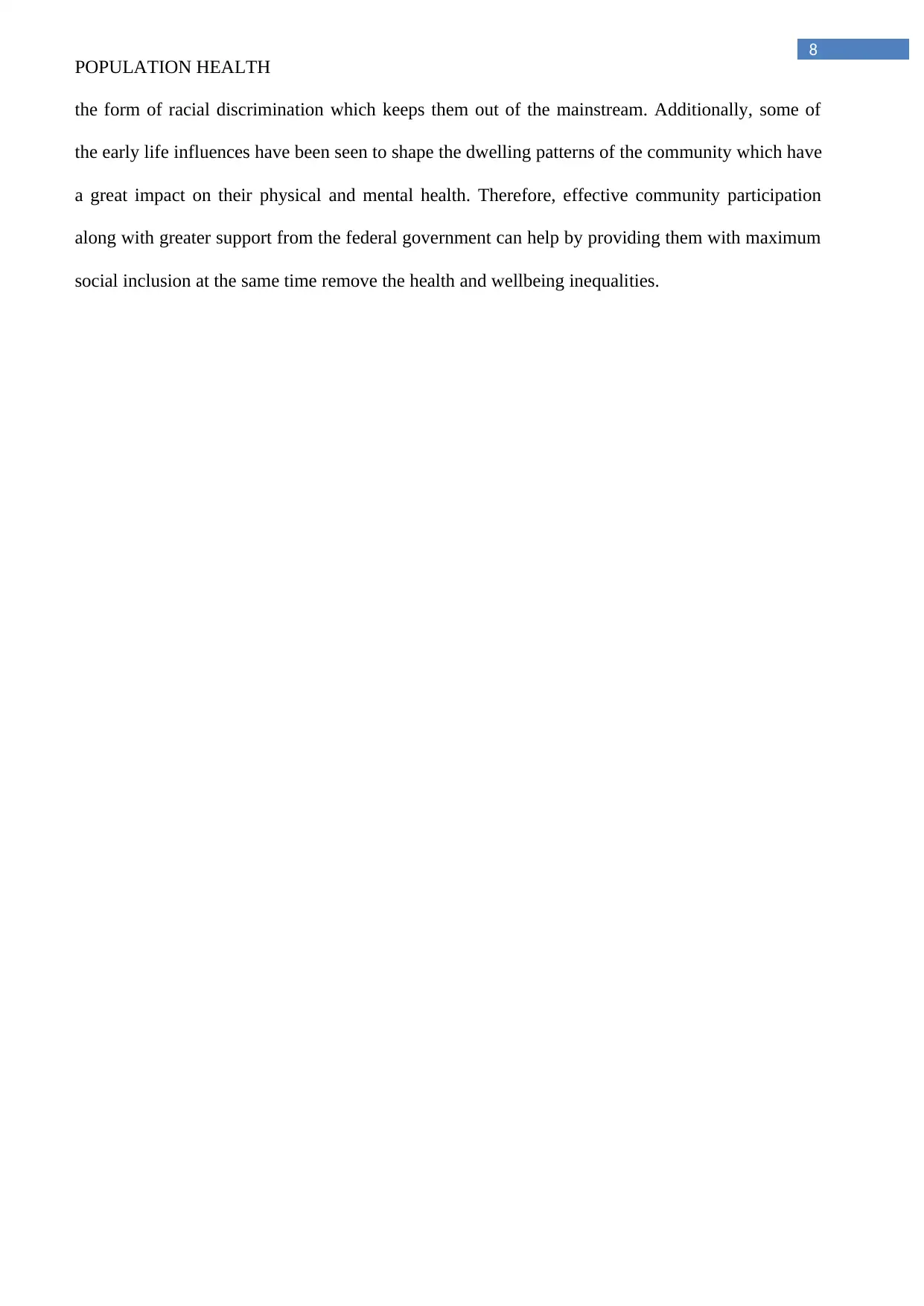
8
POPULATION HEALTH
the form of racial discrimination which keeps them out of the mainstream. Additionally, some of
the early life influences have been seen to shape the dwelling patterns of the community which have
a great impact on their physical and mental health. Therefore, effective community participation
along with greater support from the federal government can help by providing them with maximum
social inclusion at the same time remove the health and wellbeing inequalities.
POPULATION HEALTH
the form of racial discrimination which keeps them out of the mainstream. Additionally, some of
the early life influences have been seen to shape the dwelling patterns of the community which have
a great impact on their physical and mental health. Therefore, effective community participation
along with greater support from the federal government can help by providing them with maximum
social inclusion at the same time remove the health and wellbeing inequalities.
⊘ This is a preview!⊘
Do you want full access?
Subscribe today to unlock all pages.

Trusted by 1+ million students worldwide
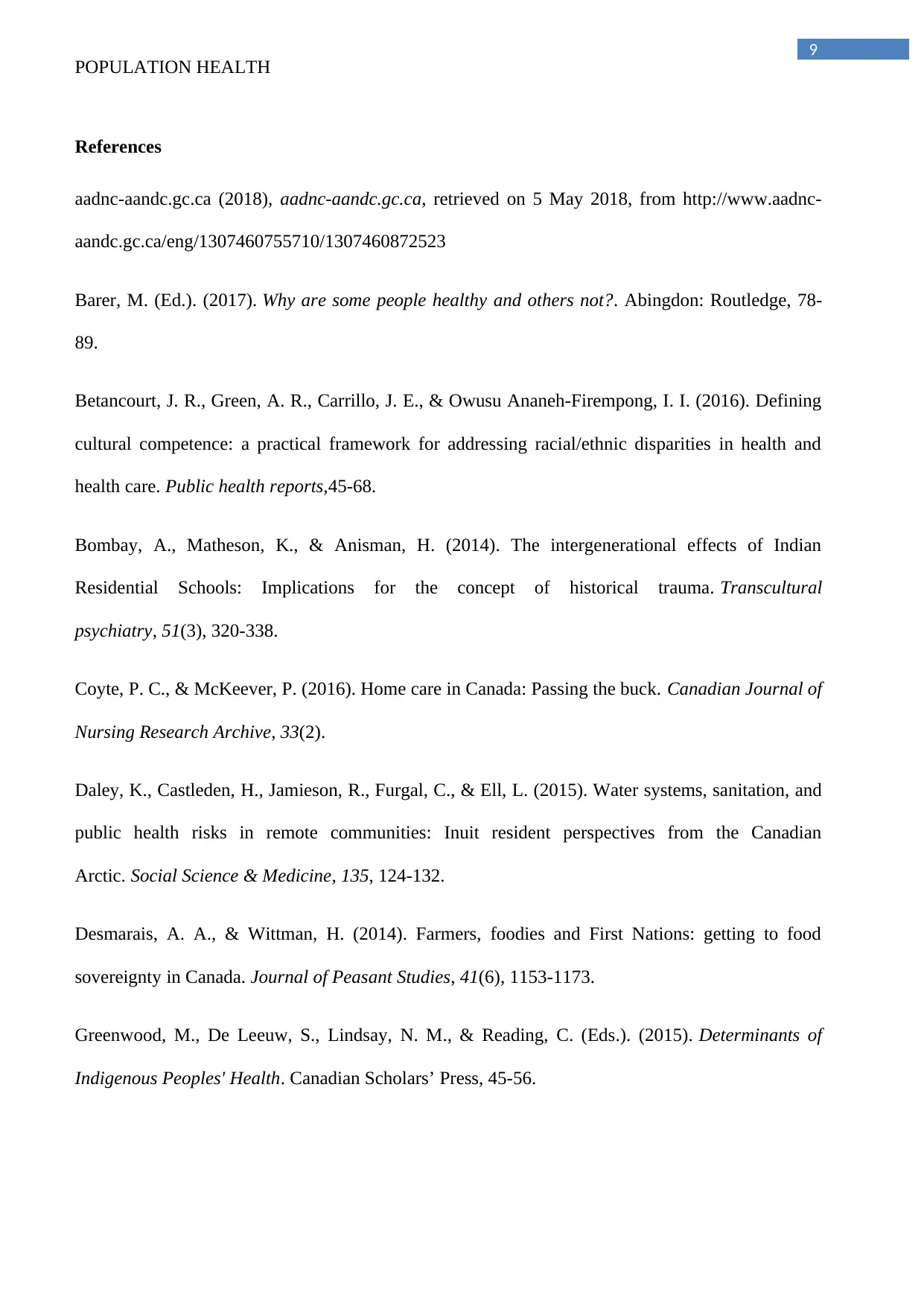
9
POPULATION HEALTH
References
aadnc-aandc.gc.ca (2018), aadnc-aandc.gc.ca, retrieved on 5 May 2018, from http://www.aadnc-
aandc.gc.ca/eng/1307460755710/1307460872523
Barer, M. (Ed.). (2017). Why are some people healthy and others not?. Abingdon: Routledge, 78-
89.
Betancourt, J. R., Green, A. R., Carrillo, J. E., & Owusu Ananeh-Firempong, I. I. (2016). Defining
cultural competence: a practical framework for addressing racial/ethnic disparities in health and
health care. Public health reports,45-68.
Bombay, A., Matheson, K., & Anisman, H. (2014). The intergenerational effects of Indian
Residential Schools: Implications for the concept of historical trauma. Transcultural
psychiatry, 51(3), 320-338.
Coyte, P. C., & McKeever, P. (2016). Home care in Canada: Passing the buck. Canadian Journal of
Nursing Research Archive, 33(2).
Daley, K., Castleden, H., Jamieson, R., Furgal, C., & Ell, L. (2015). Water systems, sanitation, and
public health risks in remote communities: Inuit resident perspectives from the Canadian
Arctic. Social Science & Medicine, 135, 124-132.
Desmarais, A. A., & Wittman, H. (2014). Farmers, foodies and First Nations: getting to food
sovereignty in Canada. Journal of Peasant Studies, 41(6), 1153-1173.
Greenwood, M., De Leeuw, S., Lindsay, N. M., & Reading, C. (Eds.). (2015). Determinants of
Indigenous Peoples' Health. Canadian Scholars’ Press, 45-56.
POPULATION HEALTH
References
aadnc-aandc.gc.ca (2018), aadnc-aandc.gc.ca, retrieved on 5 May 2018, from http://www.aadnc-
aandc.gc.ca/eng/1307460755710/1307460872523
Barer, M. (Ed.). (2017). Why are some people healthy and others not?. Abingdon: Routledge, 78-
89.
Betancourt, J. R., Green, A. R., Carrillo, J. E., & Owusu Ananeh-Firempong, I. I. (2016). Defining
cultural competence: a practical framework for addressing racial/ethnic disparities in health and
health care. Public health reports,45-68.
Bombay, A., Matheson, K., & Anisman, H. (2014). The intergenerational effects of Indian
Residential Schools: Implications for the concept of historical trauma. Transcultural
psychiatry, 51(3), 320-338.
Coyte, P. C., & McKeever, P. (2016). Home care in Canada: Passing the buck. Canadian Journal of
Nursing Research Archive, 33(2).
Daley, K., Castleden, H., Jamieson, R., Furgal, C., & Ell, L. (2015). Water systems, sanitation, and
public health risks in remote communities: Inuit resident perspectives from the Canadian
Arctic. Social Science & Medicine, 135, 124-132.
Desmarais, A. A., & Wittman, H. (2014). Farmers, foodies and First Nations: getting to food
sovereignty in Canada. Journal of Peasant Studies, 41(6), 1153-1173.
Greenwood, M., De Leeuw, S., Lindsay, N. M., & Reading, C. (Eds.). (2015). Determinants of
Indigenous Peoples' Health. Canadian Scholars’ Press, 45-56.
Paraphrase This Document
Need a fresh take? Get an instant paraphrase of this document with our AI Paraphraser
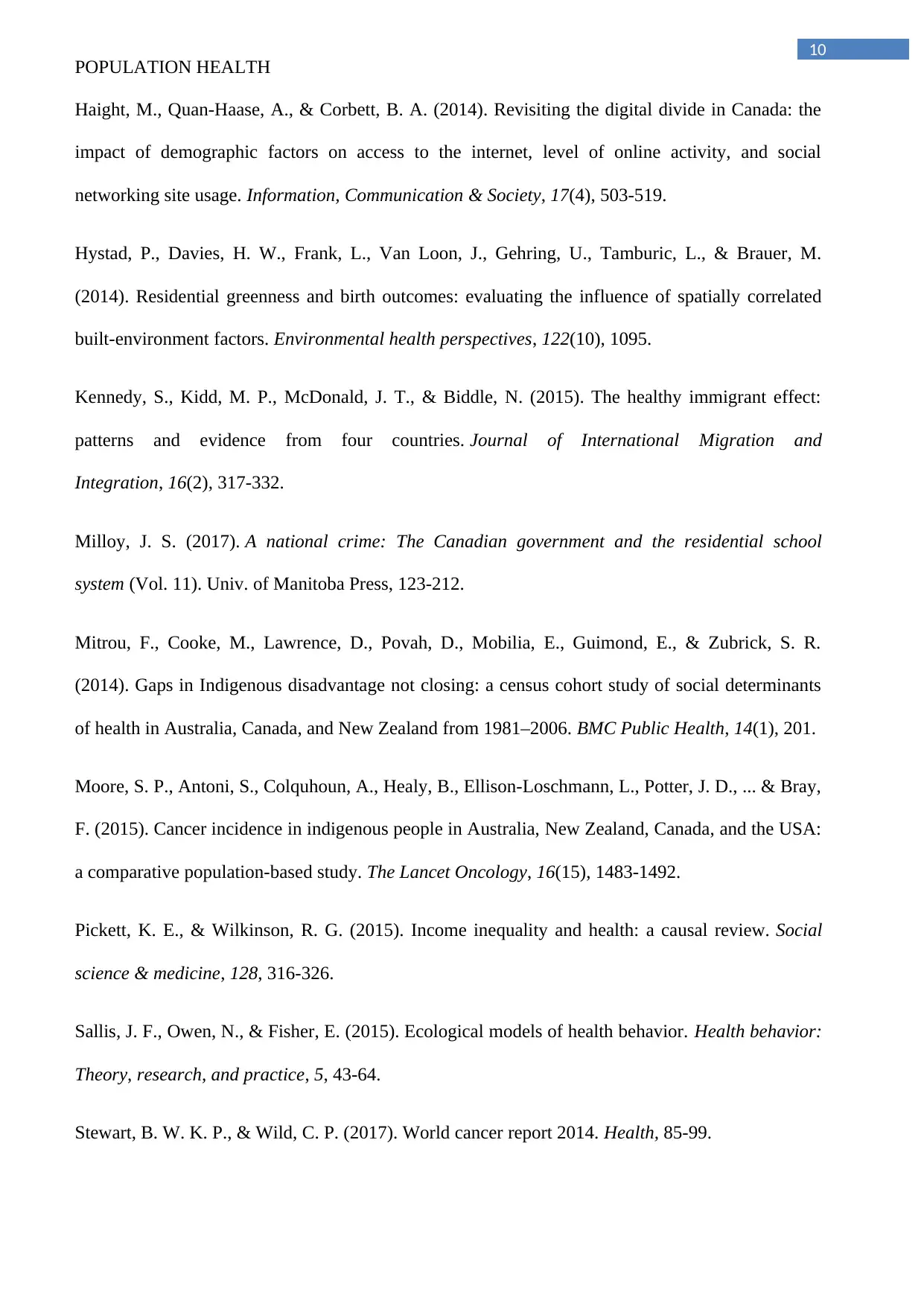
10
POPULATION HEALTH
Haight, M., Quan-Haase, A., & Corbett, B. A. (2014). Revisiting the digital divide in Canada: the
impact of demographic factors on access to the internet, level of online activity, and social
networking site usage. Information, Communication & Society, 17(4), 503-519.
Hystad, P., Davies, H. W., Frank, L., Van Loon, J., Gehring, U., Tamburic, L., & Brauer, M.
(2014). Residential greenness and birth outcomes: evaluating the influence of spatially correlated
built-environment factors. Environmental health perspectives, 122(10), 1095.
Kennedy, S., Kidd, M. P., McDonald, J. T., & Biddle, N. (2015). The healthy immigrant effect:
patterns and evidence from four countries. Journal of International Migration and
Integration, 16(2), 317-332.
Milloy, J. S. (2017). A national crime: The Canadian government and the residential school
system (Vol. 11). Univ. of Manitoba Press, 123-212.
Mitrou, F., Cooke, M., Lawrence, D., Povah, D., Mobilia, E., Guimond, E., & Zubrick, S. R.
(2014). Gaps in Indigenous disadvantage not closing: a census cohort study of social determinants
of health in Australia, Canada, and New Zealand from 1981–2006. BMC Public Health, 14(1), 201.
Moore, S. P., Antoni, S., Colquhoun, A., Healy, B., Ellison-Loschmann, L., Potter, J. D., ... & Bray,
F. (2015). Cancer incidence in indigenous people in Australia, New Zealand, Canada, and the USA:
a comparative population-based study. The Lancet Oncology, 16(15), 1483-1492.
Pickett, K. E., & Wilkinson, R. G. (2015). Income inequality and health: a causal review. Social
science & medicine, 128, 316-326.
Sallis, J. F., Owen, N., & Fisher, E. (2015). Ecological models of health behavior. Health behavior:
Theory, research, and practice, 5, 43-64.
Stewart, B. W. K. P., & Wild, C. P. (2017). World cancer report 2014. Health, 85-99.
POPULATION HEALTH
Haight, M., Quan-Haase, A., & Corbett, B. A. (2014). Revisiting the digital divide in Canada: the
impact of demographic factors on access to the internet, level of online activity, and social
networking site usage. Information, Communication & Society, 17(4), 503-519.
Hystad, P., Davies, H. W., Frank, L., Van Loon, J., Gehring, U., Tamburic, L., & Brauer, M.
(2014). Residential greenness and birth outcomes: evaluating the influence of spatially correlated
built-environment factors. Environmental health perspectives, 122(10), 1095.
Kennedy, S., Kidd, M. P., McDonald, J. T., & Biddle, N. (2015). The healthy immigrant effect:
patterns and evidence from four countries. Journal of International Migration and
Integration, 16(2), 317-332.
Milloy, J. S. (2017). A national crime: The Canadian government and the residential school
system (Vol. 11). Univ. of Manitoba Press, 123-212.
Mitrou, F., Cooke, M., Lawrence, D., Povah, D., Mobilia, E., Guimond, E., & Zubrick, S. R.
(2014). Gaps in Indigenous disadvantage not closing: a census cohort study of social determinants
of health in Australia, Canada, and New Zealand from 1981–2006. BMC Public Health, 14(1), 201.
Moore, S. P., Antoni, S., Colquhoun, A., Healy, B., Ellison-Loschmann, L., Potter, J. D., ... & Bray,
F. (2015). Cancer incidence in indigenous people in Australia, New Zealand, Canada, and the USA:
a comparative population-based study. The Lancet Oncology, 16(15), 1483-1492.
Pickett, K. E., & Wilkinson, R. G. (2015). Income inequality and health: a causal review. Social
science & medicine, 128, 316-326.
Sallis, J. F., Owen, N., & Fisher, E. (2015). Ecological models of health behavior. Health behavior:
Theory, research, and practice, 5, 43-64.
Stewart, B. W. K. P., & Wild, C. P. (2017). World cancer report 2014. Health, 85-99.
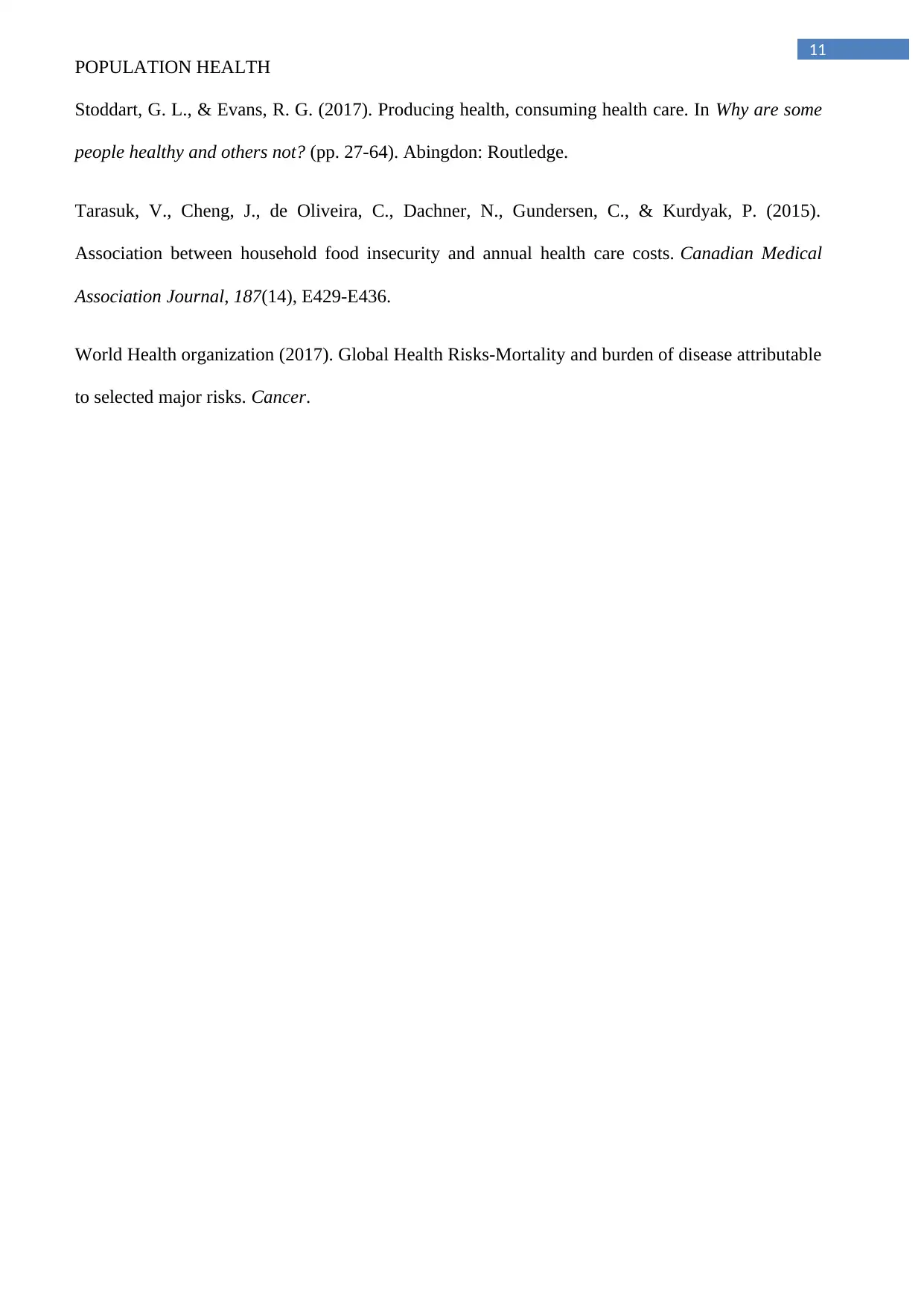
11
POPULATION HEALTH
Stoddart, G. L., & Evans, R. G. (2017). Producing health, consuming health care. In Why are some
people healthy and others not? (pp. 27-64). Abingdon: Routledge.
Tarasuk, V., Cheng, J., de Oliveira, C., Dachner, N., Gundersen, C., & Kurdyak, P. (2015).
Association between household food insecurity and annual health care costs. Canadian Medical
Association Journal, 187(14), E429-E436.
World Health organization (2017). Global Health Risks-Mortality and burden of disease attributable
to selected major risks. Cancer.
POPULATION HEALTH
Stoddart, G. L., & Evans, R. G. (2017). Producing health, consuming health care. In Why are some
people healthy and others not? (pp. 27-64). Abingdon: Routledge.
Tarasuk, V., Cheng, J., de Oliveira, C., Dachner, N., Gundersen, C., & Kurdyak, P. (2015).
Association between household food insecurity and annual health care costs. Canadian Medical
Association Journal, 187(14), E429-E436.
World Health organization (2017). Global Health Risks-Mortality and burden of disease attributable
to selected major risks. Cancer.
⊘ This is a preview!⊘
Do you want full access?
Subscribe today to unlock all pages.

Trusted by 1+ million students worldwide
1 out of 12
Related Documents
Your All-in-One AI-Powered Toolkit for Academic Success.
+13062052269
info@desklib.com
Available 24*7 on WhatsApp / Email
![[object Object]](/_next/static/media/star-bottom.7253800d.svg)
Unlock your academic potential
Copyright © 2020–2025 A2Z Services. All Rights Reserved. Developed and managed by ZUCOL.





